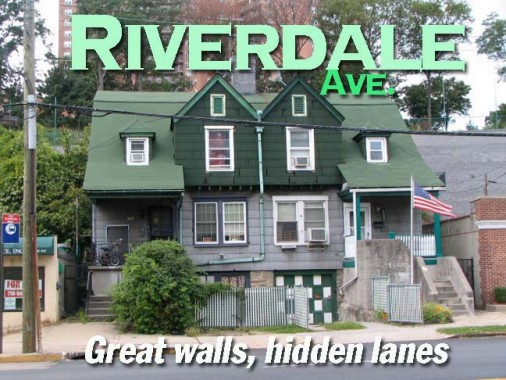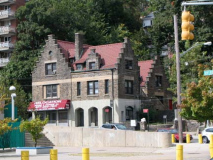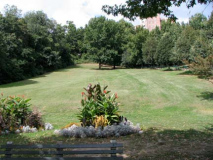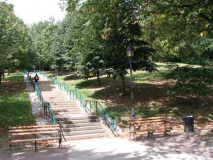Riverdale, in the northwest Bronx between approximately West 246th Street on the south, the Yonkers city line on the north, the Henry Hudson Parkway and Riverdale Avenue on the east and the Hudson River on the west (and by the communities of North and South Riverdale) is one of the city’s most piquant, and most wealthy. It features some of the borough’s most beautiful homes along country lanes that are sometimes without sidewalks, and some have only been paved within the last couple of decades.
Riverdale was developed beginning in 1852 as one of New York’s first “railroad suburb” by five wealthy businessmen who desired a community located along the New York Central’s only railroad station between Spuyten Duyvil and Yonkers. There were originally seven large estates (that remained intact until 1935) that were subsequently subdivided.
Riverdale was occupied long before 1852, however, first by the Lenape Indians; then as the estate of Adriaen Van Der Donck, a lawyer and landowner from Breda, Netherlands beginning in 1646 (whose honorific, Jonkheer, or “young lord” later became the name of the city of Yonkers); by Frederick Philipse (whose bridge spanning the Harlem River, known as Kingsbridge, gave its name to many Bronx placenames); by farmer George Hadley, whose house still stands near Van Cortlandt Park; and then by William G. Ackerman and other wealthy families, such as the Schermerhorns and Delafields, in the 1830s and 1840s. All recognized the area for its beauty but also for its relative proximity to Manhattan via Broadway, then a carriage road. The Hudson River Road (later NY Central and now Metro North) arrived in 1850: West 254th Street was originally an access road from Ackerman’s property to the tracks. A detailed account of Riverdale’s development can be found in the 1990 Landmarks Preservation Commission report of Riverdale’s landmarked section.
In September 2009 I walked Riverdale Avenue, the main north-south thoroughfare in the neighborhood (other than Broadway) which runs from West 230th Street and Johnson Avenue north to the Yonkers border (and in fact continues north in Yonkers for a couple of miles, passing the Frederick Philipse Manor National Historic Site in that city). There are several Forgotten opportunities…
West 230th Street in Riverdale runs from Broadway west to Riverdale Avenue. Spuyten Duyvil Creek, now depressed into the city’s underground water system, partially followed the path of this street between Tibbett Avenue and Broadway. The Tibbett Diner (right) on its titular street north of West 230th, was damaged by fire awhile ago but is now rebuilding. It was constructed in 1955 by Mountain View and redone in 1961 by DiRaffele.
West 230th Street continues for three blocks west as the city’s longest step street up a steep hill, eventually reaching Netherland Avenue, while Johnson Avenue continues sharply south to southern Spuyten Duyvil. At Johnson Avenue and the steps you will find this handsome Flemish-style dwelling, with the large apartment complex seen in the above photo north of the steps. In colonial days, Revolutionary Forts #2 and #3 stood just south of this location from 1776-1781.
Large, landscaped Ewen Park can be found at Riverdale Avenue’s southern stretch. The park is named for Civil War general John Ewen, who fought in NY State’s National Guard, participating in the Battle of Gettysburg. He later was elected NY City Comptroller. His daughter Eliza donated the parkland to the city in 1916, but it wasn’t opened as a park until 1935.
The Great Wall of Riverdale

In contrast to its name, Riverdale, the avenue actually runs along a high ridge. A large retaining wall was placed along the avenue between Ewen Park and west 246th Streets several decades ago, with a southbound section of Riverdale Avenue running atop the wall. It has collapsed a couple of times over the years, most recently in 2002. It’s actually a beautiful construction, resembling the high retaining wall along Riverside Drive and Castle Village that collapsed in May 2005.
The top of the Great Wall along Ewen Park. Odd object can be found atop the concrete fence at the southern end of the wall. What is it? See below.
Know your stones. Riverdale has both a Greystone Avenue and a Blackstone Avenue. I had thought Greystone may have been named for the multicolored stones in the Great Wall, but instead it honors the former William E. Dodge estate, Greyston, once the residence of NY State Governor Samuel Tilden, who outpolled Rutherford B. Hayes in the popular vote in 1876 but lost in the Electoral Commission. (Blackstone Avenue was named for the black-crystalled Fordham gneiss prevalent in the area).
I was taken by the Cyclops traffic lights that are mounted on the Great Wall and a telephone pole, unusual mountings for Cyclopes.
At Riverdale Avenue and West 236th, we see that the object at the southern end of the Great Wall was a base for a lightpost, which is still here at the north end minus its luminaire, which must have vanished decades ago. It still gets heavy use as a mount for traffic signs, while Riverdalers find the base handy as a trashcan.
Fieldston
Between West 236th Street and the Henry Hudson Parkway Riverdale Avenue becomes the shopping street associated with the LPC-designated Fieldston Historic District. Here I have pictured some of the small mom and pop shops found on Riverdale Avenue and 236th.
Fieldston was laid out in 1914 by architect Albert Wheeler, who had been hired by the Joseph Delafield estate to develop the region for residential properties. Winding roads were built that followed the region’s natural topography, in contrast to Manhattan island, whose hills had been leveled and streams forced underground into sewers. Fieldston languished, however, well into the 1920s and its residents formed the Fieldston Property Owners Association, which set strict standards for houses built here.
The Landmarks Preservation Commission report for Fieldston:
In February 1924, FPOA formed Fieldston, Inc., which raised the money to purchase all the unsold property. Fieldston, Inc. established strict design requirements and required buyers to submit houseplans to its Architectural Committee for approval. In 1928 the committee published a handbook containing names of approved architects, including, among others, Frank J. Forster, Julius Gregory, Dwight James Baum, Polhemus & Coffin, Electus D. Litchfield, and James W. O’Connor. Most owners chose Baum or Gregory, but all the architects working in Fieldston at the time designed the houses using the then popular picturesque revival styles, including the Medieval, English Tudor, Mediterranean, Dutch, and Georgian Colonial. Prominent materials include clapboard, brick, stucco, fieldstone and slate, and the buildings feature romantically composed facades with columns, porticoes, fanlights, chimneys, and steeply sloping or gambrel roofs. The designers sited the houses on their lots to take advantage of the varied and picturesque topography of the area. Many of the homes were published in leading architectural journals and magazines such as Better Homes & Gardens.
I do plan to bring the FNY camera into Fieldston Village during the winter months when the homes are not obscured by vegetation for a closer look at Fieldston, but today I chose to press further on Riverdale Avenue instead.
A couple more of the small buildings on Riverdale Avenue that contain local businesses on the ground floor. We are close ro Riverdale Avenue’s intersection with the Henry Hudson Parkway but before we get there, there’s an important local artifact to marvel at.
Bell Tower
A Riverdale touchstone is its 500-ton bell tower built by architect Dwight James Baum, who built over 100 residences in the area as well as the unusual YMCA building on West 63rd Street near Central Park. Located at the confluence of Riverdale Avenue, the Henry Hudson Parkway and West 239th Street, it was moved from its original location 700 feet to the north when the Parkway was constructed in 1936. The tower was built to house a Spanish bell cast in 1762 for a Mexican monastery, captured as spoils of victory during the Mexican War (1846-1848) by General Winfield Scott. The bell was originally placed in the fire lookout tower at Jefferson Market (6th Avenue and Christopher Street in Greenwich Village) then at a now-demolished Riverdale firehouse. It attained its final home here at the tower in 1930.
One drawback is that the bell is not readily visible without looking closely through the 8 windows at the top of the tower.
Three of the four sides of the tower have plaques inscribed with the names of all Riverdale, Kingsbridge and Spuyten Duyvil residenst who served in World War I.
Architect Baum’s name is inscribed in a colorful terra cotta plaque.
In addition, I loved the ecclesiastical, Goudy-esque type font that shows the neighborhoods.
From the Bell Tower north to West 252nd Street, Riverdale Avenue’s path is assumed by the Henry Hudson Parkway. It was one of Robert Moses’ earlier parkway engineering projects, running from the West Side Highway at West 72nd Street to Van Cortlandt Park, where it merges with the Mosholu Parkway to form the Saw Mill River Parkway in Westchester County. It was completed in the Bronx in 1937.
Gneiss is nice, that’s what they say. Some interesting residences along the Henry Hudson. There is also a generous helping of bedrock gneiss that can frequently be seen at intervals in Manhattan and the Bronx.
A short detour to Delafield Avenue and West 250th. Many area streets look like this, country lanes without sidewalks. The avenue is named for the Joseph Delafield family that owned large parcels here in the early to mid 1800s. Note “Fieldston” is misspelled on the street sign.
The beautiful Christ Church (Episcopal) can be found at the HHP and West 252nd. The country chapel was constructed by renowned ecclesiastical architect Richard Upjohn (1802-1878) in a rural Gothic style in 1866. The church, and its next door parsonage, are largely as they were when built. The chancel windows were constructed by British architect William Wailes. Upjohn’s masterwork in NYC, of course, is Broadway’s Trinity Church, constructed in 1846. Other Upjohn churches in NYC, such as St. Saviour’s in Maspeth, have not fared as well through time.
At West 254th the Henry Hudson Parkway turns to the east and Riverdale Avenue once again appears. At this juncture we can see another brief glimpse of rural Fieldston, with a couple of country homes on Grosvenor (pronounced GROVE-ner) Avenue.
Frank S. Hackett Park, at West 254th Street and Riverdale Avenue, honors the founder (1878-1952) of the Riverdale Country Day School in 1907 and Camp Riverdale in the Adirondack Mountains. Hackett Park, complete with a scenic lookout, was dedicated in 1956.
Yet another park, Vinmont Veteran Park, is across West 254th from Hackett Park. You will also find the dead end private Vinmont Road on Mosholu Avenue and West 254th — both are named for NYC Parks Department playground developer Robert C. Weinberg, who playfully named them for himself! The French Vimnont and the German Weinberg both mean “wine mountain.”
The handsome PS 81, the Robert J. Christen School, at Riverdale Avenue and West 256th Street.
Riverdale Avenue roars toward the Yonkers border as seen from West 256th Street.
A pair of venerable awning fronts in a shopping mall on Riverdale Avenue north of West 256th.
Coogan’s Bluff
One of the real pleasures I derive from Forgotten NY is the discovery of ancient streets that I never knew were there. One such case can be found on Riverdale Avenue near the mall where not one but two ancient traces can be found, neither of which appear on official city maps.
There is what appears to be an old roadhouse on the corner. We’ll revisit that presently. A look down Coogans Lane, er, West 258th reveals some ancient cottages.
Some of the small homes are in good shape, some not. They correspond to the yellow squares shown on the Bromley map. One house in particular is set back from the lane, with a lawn and lengthy driveway. In front of the lawn you see a street sign …
…that signifies yet another hidden alley running north from Coogans Alley. The DOT has even supplied it with a streetlamp. This is the first time I had suspected the presence of these two ancient lanes. Bromley shows both — if you look at the map I have helpfully inscribed “Schaefer Lane” on the map where it appears.
The owners of the house (the Schaefers) with the lawn wrote to tell me that the Schaefer Lane sign is a custom sign and wasn’t installed by the city.
Now, about that roadhouse. In the irreplaceable Bronx historian John McNamara’s great book, McNamara’s Old Bronx, he mentions a “Jumbo’s Corner” at Riverdale and West 258th. Around 1900 there was an inn at the corner, the Riverdale inn, run by a very large man named William Olms, who weighed in at over 300 pounds, and was good-naturedly called Jumbo. It’s likely that very building shown above housed the inn.
Pressing further on Riverdale Avenue, at West 259th we find great use of the Optima typefont on the Greentree Restaurant. The hand-drawn Housewares sign appears twice; around the corner is an identical sign.
On the telephone pole, there’s a rather mysterious L-shaped structure. My guess is that this formerly held a pair of street signs in a cross pattern (this type of arrangement was common in Staten Island till the 1960s).
The ashlar-bricked St. Margaret’s Parochial School, built in 1911, is on West 260th just east of Riverdale Avenue. I noticed the ecclesiastical lettering in the sign — it’s very close to the lettering on the Bell Tower on West 239th and Riverdale. both fonts were likely cut by Frederic Goudy in the early 20th Century.
I noticed this handsome onion-domed building on the corner of West 260th and Liebig Avenue 2 blocks east. Know your Bronx Avenues: Liebig is in Riverdale, while Lydig is in Morris Park
Pressing further on Riverdale Avenue, at West 259th we find great use of the Optima typefont on the Greentree Restaurant. On the telephone pole, there’s a rather mysterious L-shaped structure. My guess is that this formerly held a pair of street signs in a cross pattern (this type of arrangement was commoin in Staten Island till the 1960s). The hand-drawn Housewares sign appears twice; around the corner is an identical sign.
Meanwhile the church the school is associated with, St. Margaret of Cortona (not Crotona, by the way) was constructed in 1964, no doubt replacing an earlier church.
Margaret of Cortona (1247-1297) is the patron saint of the falsely accused; hoboes; homeless; insane; orphaned; mentally ill; midwives; penitents; single mothers; reformed prostitutes; third children; tramps.
This wonderful dormered double house can be found on Riverdale Avenue across the street from St. Margaret’s.
Last stop on Riverdale Avenue in the Bronx is the College of Mt. St. Vincent. This school has its roots in the old Academy of St. Vincent, founded in 1847 in upper Manhattan on ground now occupied by Central Park. When the City authorized the construction of Central Park in 1853, the Sisters of Charity, who ran the academy, had to cast about for a new locale and found one in 1855 in what was then part of Westchester County, the estate of the Shakesperian actor Edwin Forrest.
Forrest’s home, Fonthill, is still on the property. The Academy became the College of Mt. St. Vincent in 1911. Above we see the gate, gatehouse and main building. Among teh college’s graduates are Corazon Aquino (1933-2009) former President of the Phillippines, and Bernard McGuirk, “bald-headed stooge” producer and on-air personality on the Imus In The Morning radio show.
Note the symbol of the Riverdale Review. The avenue continues into Westchester County. As Count Dracula could not be out during the day or cross running water, I cannot cross over the boundary line out of New York City, so I ceased my northward progress here.
10/11/09



